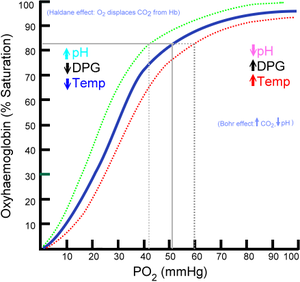Copy link
O2 transport: Quantitative aspects
Last updated: 03/05/2015
Total O2 content is expressed by the following equation:
- O2 content (CaO2) = ([SaO2 x Hgb x 1.31 ml/dl blood]) + ([0.003 ml/dl blood per mmHg x PO2)
where Hgb is hemoglobin concentration and SaO2 is hemoglobin saturation at the given PO2.
Oxygen transport is dependent on both respiratory and circulatory function. Total O2 delivery (DO2) to tissues is the product of arterial O2 content and cardiac output (QT).
- DO2 = CaO2 x QT
Note that arterial O2 content is dependent on PaO2 as well as hemoglobin concentration. As a result, deficiencies in O2 delivery may be due to a low PaO2, a low hemoglobin concentration, or an inadequate cardiac output.
The Fick equation expresses the relationship between O2 consumption, O2 content, and cardiac output:
- O2 consumption = VO2 = QT x (CaO2 – CvO2)
Oxyhaemoglobin Dissociation Curve
Consequently, the arteriovenous difference is a good measure of overall adequacy of O2 delivery. With a normal O2 consumption of approximately 250 ml/min and cardiac output of 5000 ml/min the normal arteriovenous difference is calculated to be about 5 mlO2/dl blood. The normal extraction ratio is approximately 25%, thus the body normally consumes only ~25% of the O2 carried on hemoglobin. When O2 demand exceeds supply, the extraction fraction exceeds 25%, and conversely, if O2 supply exceeds demand, the extraction fraction falls below 25%.
When DO2(oxygen delivery) is moderately reduced, VO2usually remains normal because of increased O2extraction (meaning mixed venous O2saturation decreases). With further reductions in the DO2, a critical point is reached beyond which VO2becomes directly proportional to DO2. This state of supply-dependentO2is typically associated with progressive lactic acidosis caused by cellular hypoxia.
For good measure, remember the oxygen-hemoglobin dissociation curve: A rightward shift (increasing P50) lowersO2affinity, displacesO2from hemoglobin, and makes moreO2available to tissues. A leftward shift (decreasing P50) increaseshemoglobin’saffinityforO2reducing its availability to tissues. Normal P50 in adults is 26.6 mmHg.

Other References
- Keys to the Cart: July 24, 2017; A 5-minute video review of ABA Keywords Link
Copyright Information

This work is licensed under a Creative Commons Attribution-NonCommercial-NoDerivatives 4.0 International License.